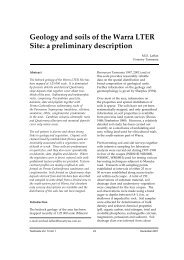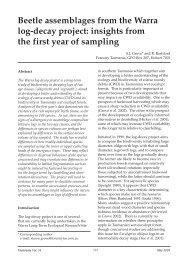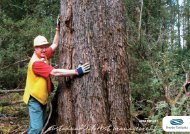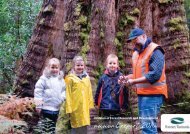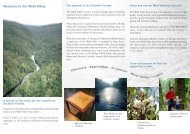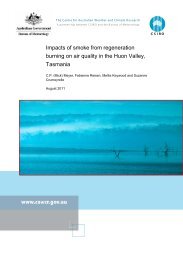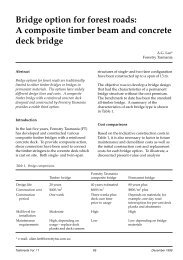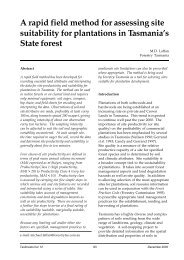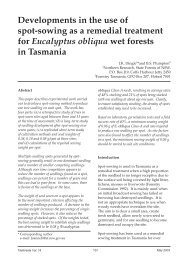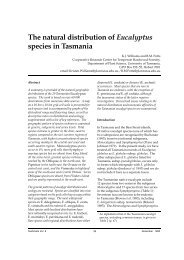annual report 2011 - Forestry Tasmania
annual report 2011 - Forestry Tasmania
annual report 2011 - Forestry Tasmania
Create successful ePaper yourself
Turn your PDF publications into a flip-book with our unique Google optimized e-Paper software.
Managing leaf beetles: how well are we doing? Can we improve?<br />
Dr Tim Wardlaw<br />
Karl Wotherspoon<br />
Leonie Jordan<br />
Tim.Wardlaw@forestrytas.com.au<br />
Karl.Wotherspoon@forestrytas.com.au<br />
Leonie.Jordan@forestrytas.com.au<br />
For the past two years, the <strong>Forestry</strong> <strong>Tasmania</strong> Forest Health<br />
Surveillance system has been used to measure how well<br />
our leaf beetle management protects plantations from<br />
defoliation. Linking records from the Forest Operations<br />
Database of leaf beetle population monitoring and control<br />
(spray) events, to assessments of end-of-season defoliation,<br />
allowed calculation of how much defoliation was prevented.<br />
The costs of management were then compared to the<br />
value of growth losses avoided. We found that spending<br />
$540,000 <strong>annual</strong>ly on leaf beetle management prevented<br />
growth losses worth $955,000 – that is, each dollar spent on<br />
management saved $1.76 from the value of the plantation<br />
estate.<br />
Leaf beetle management was most effective, and provided<br />
the greatest financial benefit, in plantations 5-6 years old.<br />
Financial benefit declined in older plantations because<br />
monitoring was less able to detect leaf beetle populations,<br />
and also because some defoliation was suffered by older<br />
plantations that were not monitored for leaf beetles: leaf<br />
beetle management has traditionally been done in younger<br />
plantations, and it is only recently that management<br />
has been extended into older plantations. If losses from<br />
no management or ineffective management in older<br />
plantations could be eliminated, the financial benefit of the<br />
program would nearly double.<br />
In a separate study, Sophie Edgar from the University of<br />
<strong>Tasmania</strong> used our operational leaf beetle population<br />
monitoring records to examine whether variation in leaf<br />
beetle populations could be predicted by site, climate<br />
or landscape attributes. Two risk factors – altitude, and<br />
proximity to Poa grasslands – were the most useful<br />
predictors of leaf beetle populations: the likelihood<br />
of leaf beetle populations being above-threshold was<br />
2-6 times higher in high-risk plantations than in lowrisk<br />
plantations. Using these factors to segregate the<br />
plantation estate into areas of low, medium and high risk<br />
of supporting above-threshold leaf beetle populations<br />
could thus provide substantial efficiency gains in leaf<br />
beetle management. Shifting from age-based targeting<br />
of plantations to risk-based targeting is predicted to result<br />
in 35% more above-threshold leaf beetle populations<br />
being detected for the same monitoring effort.<br />
<strong>Forestry</strong> <strong>Tasmania</strong> will thus be adopting risk-based<br />
targeting of plantations for managing leaf beetles in the<br />
<strong>2011</strong>-12 season. Additionally, we are refining the way we<br />
monitor leaf beetle populations to better suit the larger<br />
trees found in older plantations.<br />
This work has highlighted the value of information<br />
describing our plantation operations that has been<br />
captured in the Forest Operations Database. Combining<br />
this information with assessments of damage made by<br />
health surveillance provides a powerful tool to evaluate the<br />
effectiveness of our management.<br />
Eucalyptus leaf beetle Paropsisterna bimaculata<br />
12




